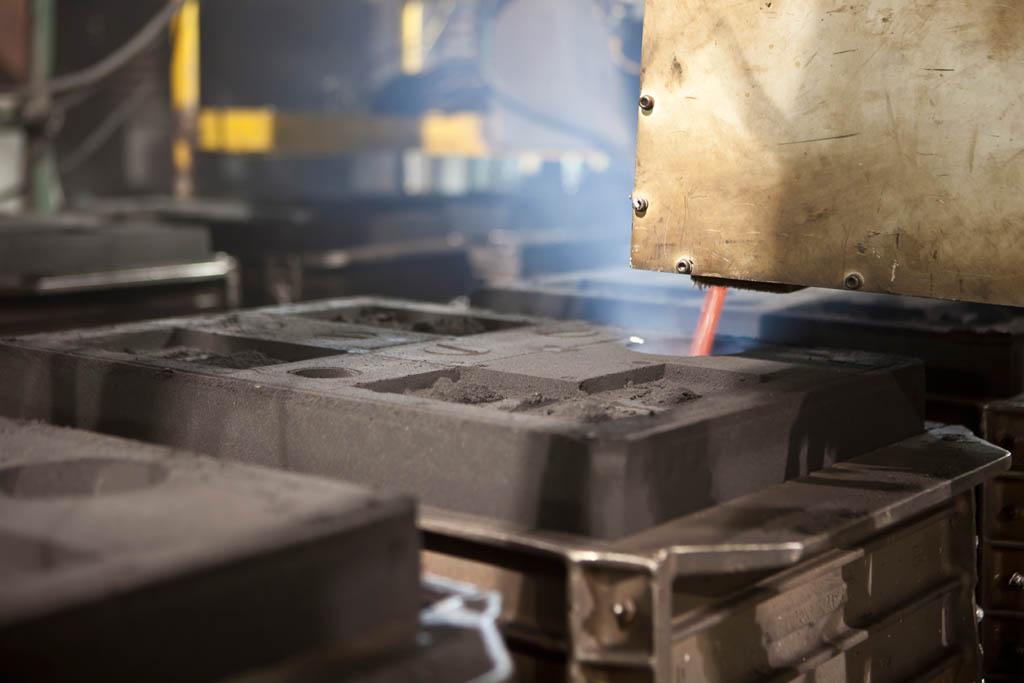With the numerous types of casting processes available, it can be difficult to know which one to choose for your product. Each process that you might consider will have different pros and cons, which will all play a role in helping you decide which process is the right one for you. This piece will help you make a well-informed decision by understanding the pros and cons of sand casting: what it is, what the potential benefits are, and what any potential drawbacks might be.
What Is Sand Casting?
Sand casting is a method of producing metal pieces from a mold made of tightly packed and bonded “sand.” While it’s helpful, at a high level, to think of this sand as the kind you might find along a shoreline, this material is made of several components — the primary one being a fine, silica-based particulate, along with water and a bonding component typically called clay.
The process works this way:
- We create a pattern for the intended shape.
- The sand is poured, packed and bonded around the pattern to form a cavity (in two halves). These are then joined to form the mold.
- We pour the molten metal material into the mold cavity through one or more runners, which we have formed into the sand mold as the entry point or points for the material.
- The molten metal cools and solidifies.
- We break the sand mold away and remove the finished part.

What Are Some of the Pros of Sand Casting?
Sand casting, as a process, has several benefits for a wide range of use cases. These include:
- Extremely low tooling cost: It is easy to form the sand material into a mold and then, after using it, break it down and reuse the sand again. Therefore sand casting has a minimal cost of tooling compared to similar processes.
- Unparalleled part versatility: The limits of sand casting are, generally, only dictated by what type of patterns you can create. Because you can make intricately detailed patterns from a variety of materials (including wood, plastic or metal), sand casting is suitable for complex pieces as well as simpler forms.
- Short lead times: Lead times for sand casting are very short (in part because of the ease of creating tooling). Do keep in mind that, depending on the finish required, sand cast parts often need additional machining.
- Suitability for low quantities: Low tooling costs and fast turnaround mean that sand casting is an ideal cost-effective process for small-quantity runs, even as low as a single piece. This makes it useful for prototyping and one-off production.
What Are Some of the Cons of Sand Casting?
The nature of sand casting means that while it offers extensive benefits in some areas, there are other applications and requirements for which it is not as well-suited. These include:
- Lower strength: Sand casting is typically unsuitable for parts requiring high tensile strength, due to the porosity of the mold. Machining or other types of molding or casting may be better able to produce the necessary density for the part.
- Pattern maintenance: Depending on how often you plan to use a pattern, maintenance and storage may be a concern. Patterns wear over time and, based on the size and shape, might be inconvenient or difficult to store.
- Lower accuracy: Sand casting is not suitable for applications requiring extremely tight tolerances. Again, in these scenarios, conventional machining is typically the more suitable option.
- Rough surface finish: Because of the nature of the sand material, the finished part will have a rough surface finish. (They are typically around 125 RMS.) Unless this is suitable for the product, it usually will require further machining and finishing.
For more information about sand casting and to learn why we’ve been leaders in the field since 1966, contact LeClaire Manufacturing today.

